2017 Alfa Romeo Giulia: Is the Wait Finally Over?
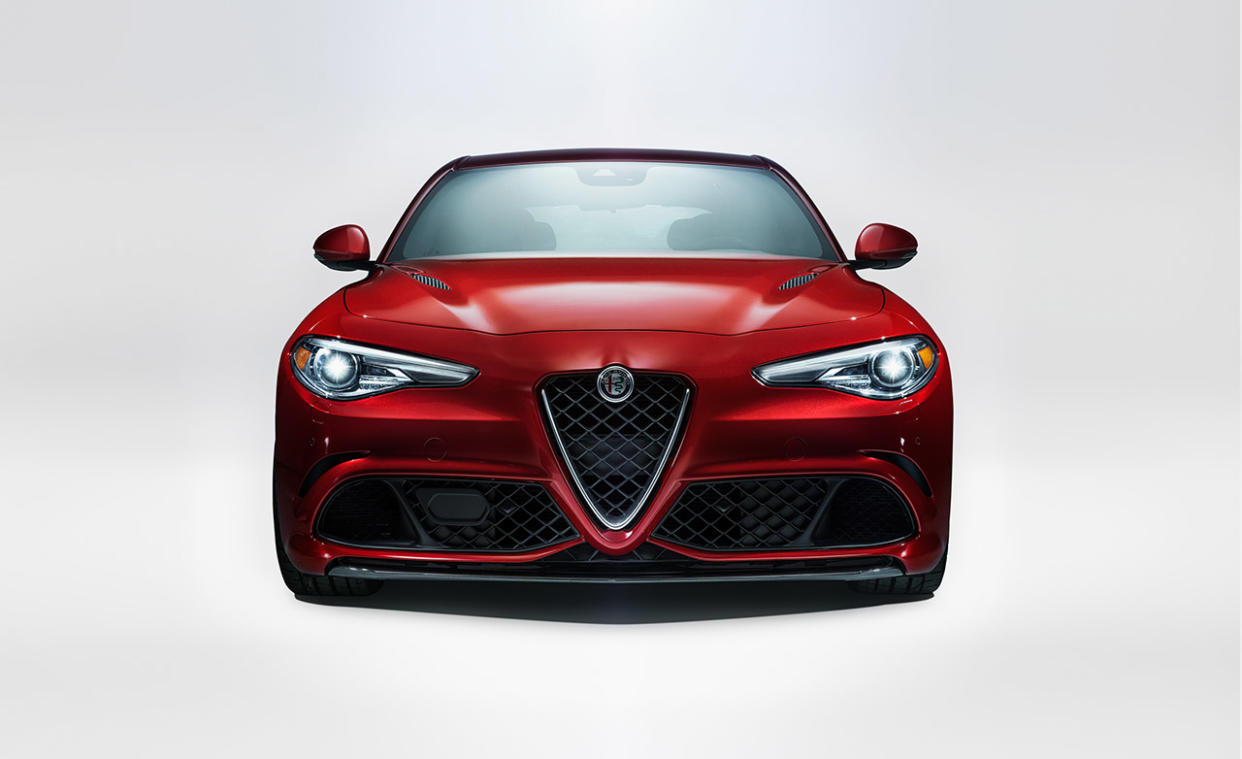
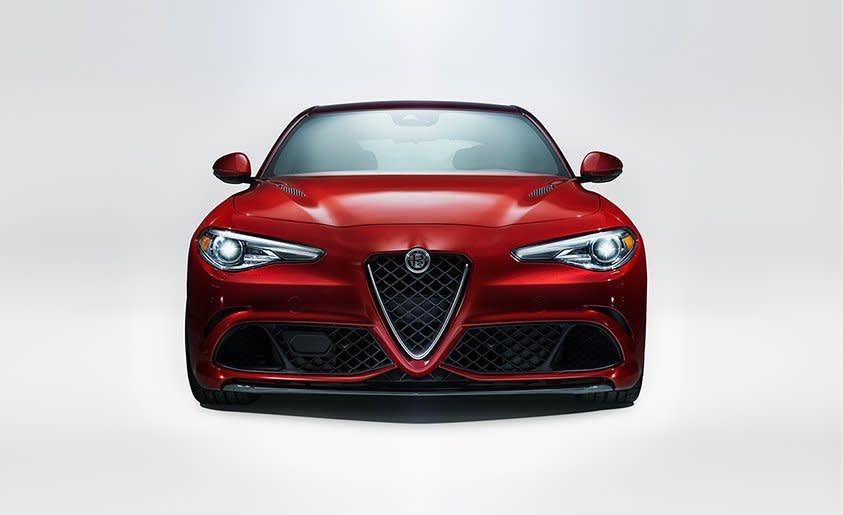
Alfa chose Giulia (Julia, in English) because Karen was taken. From the August 2016 issue
1) What’s taken so long?
The Giulia’s gestation has been as complicated as the plot line of an Italian telenovela, with its development (or lack of it) happening in parallel with Alfa Romeo’s ambition to return fully to the United States. It’s been a decade since Sergio Marchionne, then Fiat’s CEO, first promised to bring Alfa back, the merger with Chrysler in 2009 offering an obvious shortcut to making it happen. The original plan was for the Giulia to use the same Compact U.S. Wide platform that underpinned the Dodge Dart and Chrysler 200. Fortunately, that certain rendezvous with disaster was nixed, reportedly by Marchionne himself when he realized what a bad basis for an aspirational sports sedan the Dart would be.
Instead, Alfa developed a new rear-drive platform mostly by itself, the project in the hands of a small team known as the Skunks, in reference to Lockheed’s famously beyond-top-secret Skunk Works operation. The production Giulia made its debut at the Frankfurt auto show last year and will reach the U.S. in 2017. The base version will be powered by a turbocharged four-cylinder engine, with the range-topping Quadrifoglio, or “Cloverleaf,” using a 2.9-liter twin-turbo V-6 producing a BMW M3–belittling 505 horsepower.
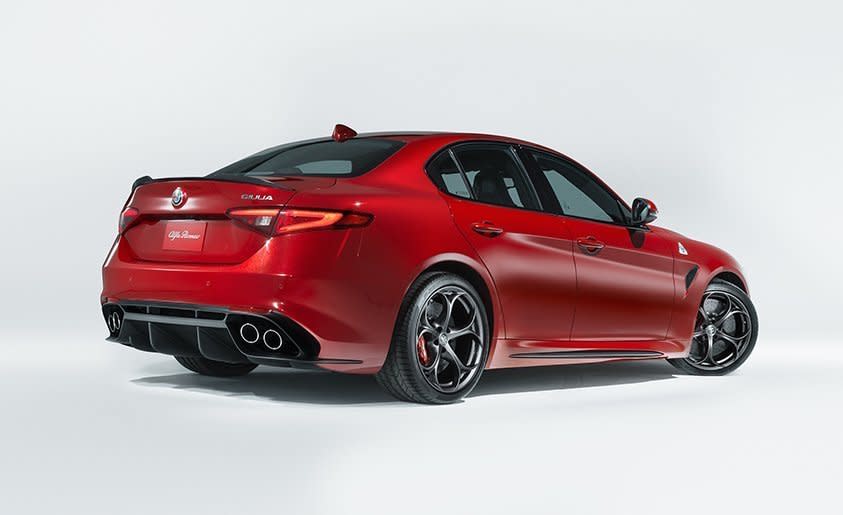
Less distinctive than its front, the Giulia Quadrifoglio’s rear at least looks as if it means business with its large aerodynamic diffuser and lip spoiler.
2) Is it finished yet?
European sales start imminently, although we’re still waiting for exact dates for the U.S. versions (all Giulias will be built in Italy at Fiat’s Cassino plant). We have driven Euro-spec models at a launch event held both on and near Fiat Chrysler Automobiles’s vast test track at Balocco in Italy. Much is impressive, but, to return to the original question of completion, we did find a surprising number of electrical idiosyncrasies in the cars we drove there, from freezing display screens to an unprompted engine-management light. We also found that the interior trim did little to debunk all those stereotypes about the quality of Italian manufacturing, with some cheap-feeling switchgear and a center console that deflected under gentle pressure.
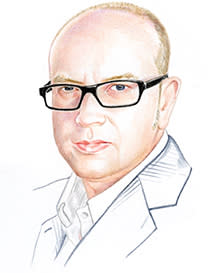
3) Who designed it?
Alfa styled the Giulia in-house, the team led by the brand’s now-former design boss Marco Tencone, who has been replaced by former Dodge and SRT chief designer Scott Kruger. (Other departures from the senior team behind the Giulia include engineering boss Philippe Krief and—as we close for press—CEO Harald Wester. It’s like the end of The Godfather, and seeming proof that Marchionne hasn’t appreciated the delayed launch.) The Giulia’s face is pure Alfa, but from other angles it reveals more influences than a teenage funk-soul-reggae-fusion band, from the Kia Optima to the Infiniti Q50. In profile, it looks as if it’s trying to be an Italian E46 BMW, even sporting a Hofmeister kink in its rear window.

4) Is it a real Alfa?
Yes, and the realest in many years. Although Alfa has managed to produce some truly special limited-run sports cars during its protracted malaise, it’s been a long time since any of its volume models were anything other than thinly disguised Fiat Group platform clones. Alfa’s last sedan, the 159, sat on a Fiat-GM platform of such mediocrity that GM refused to use it for any of its own models.

Right: The driver in the above photo has clearly activated race mode. It’s the only setting in which the Giulia Quadrifoglio is allowed to hang its tail.
5) What’s the Quadrifoglio like to drive?
Alfa would only let us try it on Balocco’s handling course, with the straights broken up by temporary chicanes to make sure we didn’t accidentally validate the claimed 191-mph top speed. Our time in the car was limited by the fact that more than 50 journalists were waiting to experience just four Quadrifoglii, which led to longer lines than those at the Mustang Ranch on two-for-one day. However, our elbows are the sharpest in the business, and we got to experience both manual and automatic versions of the Quadrifoglio, albeit briefly. Read our first drive review ››
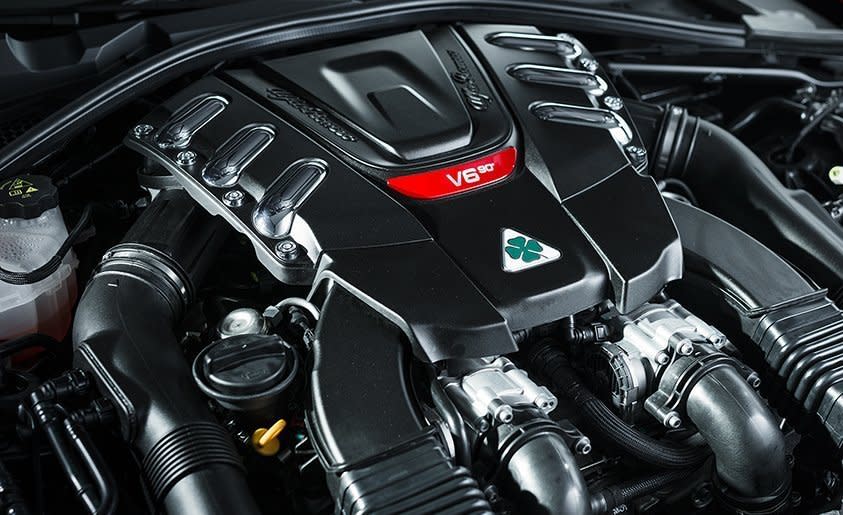
6) Does it really have 505 horsepower?
Most won’t, but one does. The European-market powertrains we drove at Balocco have limited U.S. relevance. There was a 197-hp four-cylinder gasoline turbo and two 2.2-liter turbo-diesels, none of which are scheduled to come here. We’ve been told that the base U.S. spec will be a brawnier 276-hp turbocharged four. Fortunately, we didn’t leave Balocco without driving the range-topping Quadrifoglio, which will definitely be heading stateside. It does indeed have a claimed 505 horsepower.
The official line is that this engine is “inspired by Ferrari technology and technical skills,” which it is, being basically a six-cylinder sister to the Ferrari-designed F154 turbocharged V-8 that powers the 488GTB, California T, and Maserati Quattroporte GTS. Peak power comes at 6500 rpm, with the limiter set at 7000 rpm. The V-6 drives the Quadrifoglio’s rear wheels through either a six-speed manual or an eight-speed automatic gearbox and then a clever torque-biasing rear differential.

7) What about the standard car?
We were allowed to drive the basic Euro-spec Giulia on the road and can report that it seems to cope extremely well with the real world. Or, at least, rural Italy. Refinement is outstanding, the Giulia subjectively rivaling the Mercedes-Benz C-class in both noise and ride quality. A 100-mph cruise on the autostrada provoked a minimum of road and wind roar while the chassis shrugged off the roughest roads we could find. The high-geared steering delivers keen responses, although there’s little feel behind the power assistance. There’s also less low-speed understeer than in the current BMW 3-series or Audi A4. Besides the not-for-U.S. diesels, we also experienced the European gasoline engine, which augurs well for the more powerful version that will make it here. Even with 197 horsepower, it pulls hard. In the manner of modern small-capacity turbo engines, though, it isn’t keen on revving beyond 5500 rpm.

8) Does it sound good?
The Quadrifoglio sounds great—snarling, angry, and very Modenese. Nobody can make a V-6 with more aural appeal than the Italians. The four-cylinder gasoline engine also reveals an impressively hard-edged bark when being worked. The diesels sound like diesels, but that shouldn’t matter to us.
9) What else will be built on this platform?
Lots. Alfa’s turnaround plan involves a total of eight new models, with all of them (except 4C variants) set to use some version of the Giulia’s platform and to be either rear- or all-wheel drive. The next, driven by market demands, is likely to be a small crossover, followed by a rear-drive replacement for the current European Giulietta hatchback. It’s also possible that the production version of Maserati’s Alfieri coupe concept from 2014 will be spun from the same architecture.

Left: The Quadrifoglio’s spindly wheels subtly recall Alfa’s classic five-hole wheels. They cover optional Brembo-sourced carbon-ceramic brake rotors. Right: The Giulia’s interior design is stylish without seeming overwrought.
10) Where will FCA sell them?
Alfa’s lofty position within FCA has allowed the brand to expand its U.S. dealer presence, even with only the 4C to sell. There are already 139 dealers in the States, with the promise of more to come. Coverage in California and the Eastern Seaboard looks good, as it does around other large metropolitan areas. Beyond that, things get patchy, especially in the Northwest. Currently there isn’t a franchise between Spokane and Minneapolis, although we’re told the brand is planning to expand its network ahead of the start of Giulia sales.

11) Does it have a shot against the BMW M3 and the Mercedes-AMG C63?
Yes, and a good one. The Quadrifoglio outguns all its obvious rivals by an impressive margin and, based on our limited first impression, delivers more emotional appeal than any of them. This is one comparison test that we’re looking forward to.


